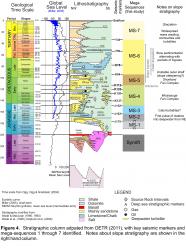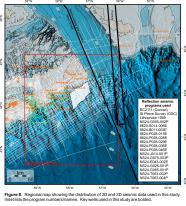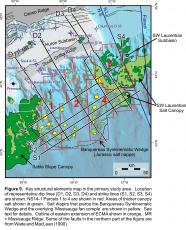Database and Approach
Database and Approach
Building on the seismic stratigraphic framework proposed in OETR (2011) and CNSOPB (2013), 12 regional seismic horizons were correlated across the shelf and slope of the study area (Fig. 4), and were used to generate time-structure and time-thickness maps. For deeper horizons, on-the-fly post-stack filtering (band-pass Ormsby filter) was applied during horizon correlation to remove some of the frequency components (commonly below 4 Hz and varying amounts of the higher frequency component). The use of multiple filters allowed the highest confidence correlation of challenging markers like the top basement surface.
The seismic data-base is comprised of one 3D survey (referred to as the “Stonehouse 3D”) and numerous 2D seismic programs that were collected during the 1980’s to early 2000’s (see Fig. 8 for a list of programs used). Middle Jurassic and younger strata on the outer shelf are calibrated by wells like W. Esperanto B-78, SW Banquereau F-34, Banquereau C-21, N. Banquereau I-13, Citadel H-52, Louisbourg J-47, S. Griffin J-13, Sachem D-76, Hesper P-52, and Dauntless D-35 (Fig. 9). Deepwater calibration is provided only by Tantallon M-41 for strata younger than Valanginian. Biostratigraphic interpretations from W. Esperanto B-78, Hesper P-52, Dauntless D-35, S. Griffin J-13, and Tantallon M-41 were recently re-examined by Weston et al. (2012) and their age designations are favoured in this report.
Because deepwater calibration in the study area is limited to Tantallon M-41 (Weston et al., 2012), age constraints for pre-Valanginian slope strata require correlation of shelf horizons across poorly imaged growth faults or must be based on other indirect lines of evidence like seismic stratigraphic relationships. Tentative age constraints for seismic markers outboard the BSW, on the Sohm Abyssal Plain, are however provided by Ebinger and Tucholke (1988) and Swift et al. (1986) who used sparse multichannel seismic profiles (collected in 1978) tied across long distances to Deep-Sea Drilling Project (DSDP) Site 384 on the J-Anomaly Ridge. For older seismic horizons (pre-Eocene), they also used the reflection terminations (pinch-outs) onto oceanic crust to propose maximum ages for seismic markers based on interpreted ages of magnetic anomalies. The Jurassic Magnetic Quiet Zone (JMQZ - Vogt, 1973), however, contains no coherent magnetic lineations outboard the ECMA, and so this approach for strata older than anomaly M22 (~151 Ma) required extrapolations of seafloor spreading half-rates from younger anomalies (Ebinger and Tucholke, 1988). Because there is some uncertainty regarding exactly where a given seismic marker pinches out, and additional uncertainty about Jurassic seafloor spreading rates, age constraints for pre-Mid-Jurassic strata in the Sohm Abyssal Plain in particular should be regarded as approximate.




